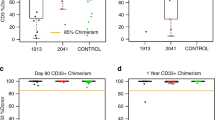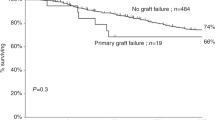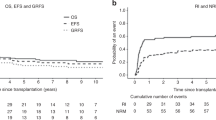Summary:
Second allogeneic bone marrow transplantation (BMT) for AML relapsing after an initial BMT has a poor prognosis, with a probability of a 2-y disease-free survival below 30 per cent, caused both by treatment-related mortality (TRM) and high relapse rate. While TRM is most likely due to heavy pretreatment, AML relapse after BMT may be due to resistant disease or to a poor graft-versus-leukaemia (GvL) effect of the transplant. The degree of GvL may depend on individual donor/recipient immunoreactivity. In most published cases of second allogeneic BMT, both transplants were performed from the same donor. Here, we describe a patient who was first transplanted for acute promyelocytic leukaemia (APL) (AML FAB M3v) from his HLA-identical brother and received intensive immunotherapy including donor lymphocytes and IL2. He remained free from GvHD >I°, but developed CNS relapse. After a second BMT from another HLA-identical brother, he spontaneously developed GvHD III°, and has now been disease free for nearly 3 years. In this patient, long-term remission of AML relapsing after BMT was achieved by combining remission induction using an individual chemotherapy protocol with a second BMT from an alternative matched related donor and transient GvHD III°, which probably conferred a GVL effect.
This is a preview of subscription content, access via your institution
Access options
Subscribe to this journal
Receive 12 print issues and online access
$259.00 per year
only $21.58 per issue
Buy this article
- Purchase on Springer Link
- Instant access to full article PDF
Prices may be subject to local taxes which are calculated during checkout
Similar content being viewed by others
References
Wolff SN . Second hematopoietic stem cell transplantation for the treatment of graft failure, graft rejection or relapse after allogeneic transplantation. Bone Marrow Transplant 2002; 29: 545–552.
Bosi A, Laszlo D, Labopin M et al. Second allogeneic bone marrow transplantation in acute leukemia: results of a survey by the European Cooperative Group for Blood and Marrow Transplantation. J Clin Oncol 2001; 19: 3675–3684.
Munoz A, Badell I, Olive T et al. Second allogeneic hematopoietic stem cell transplantation in hematologic malignancies in children: long-term results of a multicenter study of the Spanish Working Party for Bone Marrow Transplantation in Children (GETMON). Haematologica 2002; 87: 331–332.
Devine SM, Sanborn R, Jessop E et al. Fludarabine and melphalan-based conditioning for patients with advanced hematological malignancies relapsing after a previous hematopoietic stem cell transplant. Bone Marrow Transplant 2001; 28: 557–562.
Gonzalez M, Barragan E, Bolufer P et al. Pretreatment characteristics and clinical outcome of acute promyelocytic leukaemia patients according to the PML-RAR alpha isoforms: a study of the PETHEMA group. Br J Haematol 2001; 114: 99–103.
Nabhan C, Mehta J, Tallman MS . The role of bone marrow transplantation in acute promyelocytic leukemia. Bone Marrow Transplant 2001; 28: 219–226.
Biondi A, Luciano A, Bassan R et al. CD2 expression in acute promyelocytic leukemia is associated with microgranular morphology (FAB M3v) but not with any PML gene breakpoint. Leukemia 1995; 9: 1461–1466.
Rovelli A, Biondi A, Cantu Rajnoldi A et al. Microgranular variant of acute promyelocytic leukemia in children. J Clin Oncol 1992; 10: 1413–1418.
Reinhardt D, Langebrake C, Creutzig U et al. Minimal residual disease in acute myeloid leukemia in children–standardization and evaluation of immunophenotyping in the AML-BFM-98 study. Klin Padiatr 2002; 214: 179–187.
Asou N, Adachi K, Tamura U et al. Analysis of prognostic factors in newly diagnosed patients with acute promyelocytic leukemia: the APL92 study of the Japan Adult Leukemia Study Group (JALSG). Cancer Chemother Pharmacol 2001; 48 (Suppl. 1): S65–S71.
Reinhardt D, Hempel G, Fleischhack G et al. Liposomal daunorubicine combined with cytarabine in the treatment of relapsed/refractory acute myeloid leukemia in children. Klin Padiatr 2002; 214: 188–194.
Lee ST, Jang JH, Suh HC et al. Idarubicin, cytarabine, and topotecan in patients with refractory or relapsed acute myelogenous leukemia and high-risk myelodysplastic syndrome. Am J Hematol 2001; 68: 237–245.
Estey EH, Thall PF, Cortes JE et al. Comparison of idarubicin +ara-C-, fludarabine + ara-C-, and topotecan + ara-C-based regimens in treatment of newly diagnosed acute myeloid leukemia, refractory anemia with excess blasts in transformation, or refractory anemia with excess blasts. Blood 2001; 98: 3575–3583.
Zamboni WC, Luftner DI, Egorin MJ et al. The effect of increasing topotecan infusion from 30 minutes to 4 hours on the duration of exposure in cerebrospinal fluid. Ann Oncol 2001; 12: 119–122.
Martino R, Caballero MD, Simon JA et al. Evidence for a graft-versus-leukemia effect after allogeneic peripheral blood stem cell transplantation with reduced-intensity conditioning in acute myelogenous leukemia and myelodysplastic syndromes. Blood 2002; 100: 2243–2245.
Zecca M, Prete A, Rondelli R et al. Chronic graft-versus-host disease in children: incidence, risk factors, and impact on outcome. Blood 2002; 100: 1192–1200.
Litvinova E, Maury S, Boyer O et al. Graft-versus-leukemia effect after suicide-gene-mediated control of graft-versus-host disease. Blood 2002; 100: 2020–2025.
Ruggeri L, Capanni M, Casucci M et al. Role of natural killer cell alloreactivity in HLA-mismatched hematopoietic stem cell transplantation. Blood 1999; 94: 333–339.
Schmaltz C, Alpdogan O, Horndasch KJ et al. Differential use of Fas ligand and perforin cytotoxic pathways by donor T cells in graft-versus-host disease and graft-versus-leukemia effect. Blood 2001; 97: 2886–2895.
Dickinson AM, Wang XN, Sviland L et al. In situ dissection of the graft-versus-host activities of cytotoxic T cells specific for minor histocompatibility antigens. Nat Med 2002; 8: 410–414.
Author information
Authors and Affiliations
Corresponding author
Rights and permissions
About this article
Cite this article
Classen, C., Debatin, KM., Friedrich, W. et al. Long-term remission of APL with a second allogeneic BMT after CNS relapse following HLA-identical allogeneic BMT. Bone Marrow Transplant 32, 843–846 (2003). https://doi.org/10.1038/sj.bmt.1704225
Received:
Accepted:
Published:
Issue Date:
DOI: https://doi.org/10.1038/sj.bmt.1704225
Keywords
This article is cited by
-
Multiple isolated extramedullary relapse of acute promyelocytic leukemia after allogeneic hematopoietic stem cell transplant: a case report and review of literature
SpringerPlus (2013)
-
Treatment of splenic marginal zone lymphoma of the CNS with high-dose therapy and allogeneic stem cell transplantation
Experimental Hematology & Oncology (2012)
-
Incidence of extramedullary disease in patients with acute promyelocytic leukemia: a single-institution experience
International Journal of Hematology (2009)



